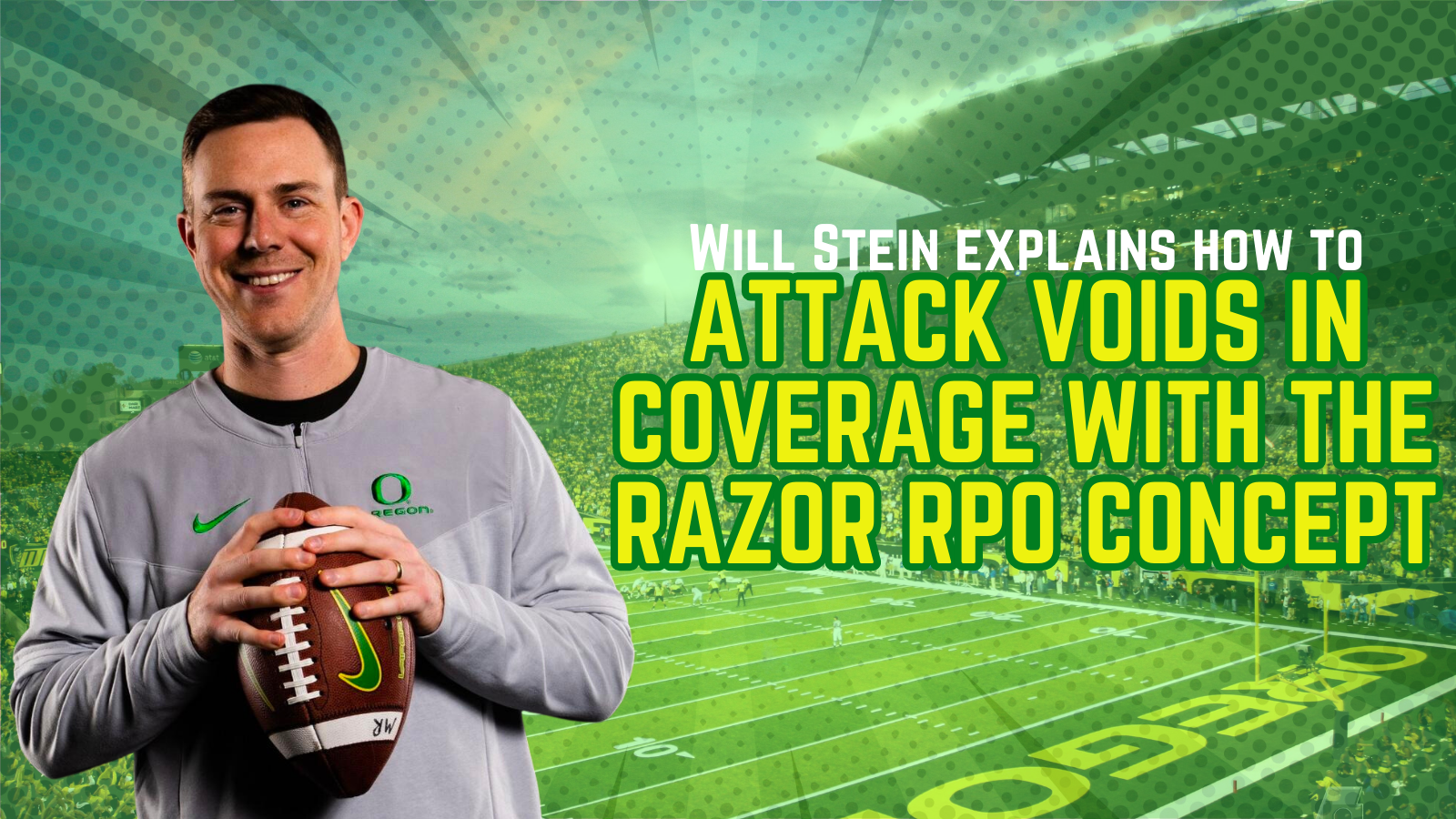
The “arrow” RPO which pairs bubble blocking by perimeter blocking with an arrow route from a tight end or receiver has become an extremely popular way to attack the defense. It became so popular that the UFL San Antonio Brahmas Offensive Coordinator AJ Smith called it the “RPO of the Year” in 2022 on Coach and Coordinator Podcast’s OC Office Hours Series. Like anything that has become popular, it’s opened opportunities for new concepts that affect the defense in different ways.
One of those is in the Oregon Ducks playbook. Will Stein, Oregon’s Offensive Coordinator, has a concept that he calls the “Razor” concept. This play, which has gained popularity in both college football and the NFL, emphasizes explosive, downfield opportunities while maintaining the threat of the inside running game. Here’s a detailed breakdown of how the Razor concept works, why it’s effective, and when to deploy it.
The Basics of the Razor Concept
At its core, the Razor concept is a post-rail combination that Stein has integrated into Oregon’s offense to create mismatches and put defenses in tough situations. It is a zone-read play with quarterback reading the defense’s movements to determine whether to hand off the ball or keep it for a passing opportunity.
Stein emphasizes that Razor is not a “naked” play, which typically refers to a play-action pass without offensive line protection. Instead, Razor offers the quarterback a reliable read, allowing them to decide whether to hand off the ball or exploit the defense with a rail route over the top of the coverage.
Key Components:
- Peaking the Rail: The rail route is one of the play’s most dangerous aspects. As the quarterback meshes with the running back, he’s peaking at the rail route to see if there is an opportunity for a big play. This rail route gives the quarterback a deep downfield option.
- Area Read: Razor maintains the principles of an area read, where the quarterback makes decisions based on how defenders, especially the backside linebackers, react. If defenders commit to the run, the rail or post becomes an attractive passing option.
- Versatility Across Formations: The Razor concept can be used in various personnel packages. Whether it’s an open set, a bunch formation, or 11 or 12 personnel, the quarterback’s read remains consistent. The offensive setup and motion allow for different looks while maintaining the core principles of the play.
When to Use the Razor Concept
Stein particularly likes running Razor against Cover 3 and quarters coverage. These defensive schemes, which often leave deep zones uncovered, are vulnerable to the rail route attacking a void in the coverage. The Razor concept provides a great opportunity for a big play downfield when the secondary is preoccupied with covering the deep middle or sideline zones.
Applications in the Red Zone
Razor is also effective in the red zone, especially against edge pressure or zero coverage with no deep safety help. Stein likes to run the concept from a two-tight-end wing set in these situations, which offers extra protection against blitzes while still providing the opportunity to hit the rail route over the top for a touchdown.
Advantages of Razor
- Flexible Personnel Groupings: Razor can be run from multiple personnel groupings and alignments, making it hard for defenses to predict. From 12 personnel with a lead zone, to an 11 personnel set, the variations allow the offense to stay unpredictable.
- Post-Read Option: The post route gives the offense an additional downfield weapon. By combining the post with the rail route, Razor provides the quarterback with multiple opportunities to exploit defensive lapses.
- Balanced Threat: Razor works effectively as a balanced run-pass option. The quarterback has the freedom to either exploit the defense with the run or, if the defense overcommits, hit a big passing play.
Razor in Action
Stein has seen success with Razor, particularly in games where defenses play aggressively against the run. The concept has been used extensively across college football, and even in the NFL, where teams like the Miami Dolphins have adopted similar schemes.
The Razor concept is a modern, versatile tool in Oregon’s offensive arsenal. By combining a strong running threat with explosive passing options, it forces defenses to respect both the run and the pass, creating opportunities for big plays. The concept’s flexibility allows it to be used in a variety of situations and formations, making it a key element of any game plan.


